Optimal DG Placement to Find Optimal Voltage Profile Considering Minimum DG Investment Cost in Smart Neighborhood
Abstract
:1. Introduction
1.1. Background and Literature Review
- The potential of each of the RE carriers
- Identification and selection of suitable areas (site-finding)
- A revised perspective for the future of REs
- Economic justification according to various factors
- Planning, mode and capacity of investment, with prioritization of each RE
- A proper planning to develop technology
- Capacity and substitution capability
1.2. Importance and Necessity of the Research
1.3. Optimal Placement of Distributed Generators in Power Distribution Systems
1.4. Motivation and Main Contribution
1.5. Paper Structure
2. Voltage Stability and Reducing Losses in Distribution Networks
2.1. Voltage Stability
2.2. Important Benefits of Using Distributed Generatiors in Power Network
2.2.1. Power Supply
2.2.2. Reserved Power
2.2.3. Load Flow Analysis
2.2.4. Improving Power Quality and Reliability
2.2.5. Improving Voltage Profile
2.2.6. Increasing the Life of Equipment
2.2.7. Reducing Losses
2.2.8. Distributed Generation and Environmental Issues
3. Proposed Tools for DG Allocation to Reduce Losses and Increase Voltage Stability
3.1. Reasons for the Use of Evolutionary Algorithms
- Genetic Algorithms (GA) provided by Holland and studied by Goldberg
- Evolutionary Strategies (ES) presented by Rechenberg and Schwefel
- Evolutionary Planning (EP) provided by L.J. Fogel et al. modified by D.B. Fogel
3.2. Objective Function Optimizer Algorithm
3.3. Problem Modeling without Considering Greenhouse Gas Costs
3.4. Problem Modeling Considering the Cost of Greenhouse Gases
- Determining the buses that DGs are installed on; (33 variables per 33 buses);
- Determining the type of DGs that are assigned on the buses defined in item 1; (33 variables for 33 buses);
- Determining the working range of each of the DGs installed in item 2; (33 variables for 33 buses);
3.5. Optimal Placement of DGs in 33-Bus Network
- The first step is to create a 33-base model of the IEEE standard with the aid of matrixes;
- The second step is to create various constraints on the system specification in order to make the model more realistic;
- Step three is generating random responses and calculate the extent to which responses are violated from the problem space;
- Step four is applying random answers to the target function and the penalty function to calculate the cost of each response;
- Step five is comparing responses and find the lowest cost among all the search methods
- The sixth stage is displaying the output response as to which DG type with a few percent of the maximum power on which bus to use.
4. Results of Optimal DGs Placement in the IEEE 33-Buss Networks
5. Conclusions
Author Contributions
Funding
Conflicts of Interest
References
- Gazijahani, F.S.; Ravadanegh, S.N.; Salehi, J. Stochastic multi-objective model for optimal energy exchange optimization of networked microgrids with presence of renewable generation under risk-based strategies. ISA Trans. 2018, 73, 100–111. [Google Scholar] [CrossRef]
- Yazdi, S.S.H.; Milimonfared, J.; Rouzbehi, K. Incorporation of synchronous power controlled energy storage system in wind farms to provide inertial and primary frequency support. In Proceedings of the Iranian Conference on Electrical Engineering (ICEE), Mashhad, Iran, 8–10 May 2018; pp. 1379–1384. [Google Scholar]
- Ghiasi, M. Detailed study, multi-objective optimization, and design of an AC-DC smart microgrid with hybrid renewable energy resources. Energy 2019, 169, 496–507. [Google Scholar] [CrossRef]
- Javadi, M.S.; Razavi, S.-E.; Ahmadi, A.; Siano, P. A novel approach for distant wind farm interconnection: Iran South-West wind farms integration. Renew. Energy 2019, 140, 737–750. [Google Scholar] [CrossRef]
- Pourbehzadi, M.; Niknam, T.; Aghaei, J.; Mokryani, G.; Shafie-khah, M.; Catalão, J.P.S. Optimal operation of hybrid AC/DC microgrids under uncertainty of renewable energy resources: A comprehensive review. Int. J. Electr. Power Energy Syst. 2019, 109, 139–159. [Google Scholar] [CrossRef]
- Pirouzi, S.; Aghaei, J.; Vahidinasab, V.; Niknam, T.; Khodaei, A. Robust linear architecture for active/reactive power scheduling of EV integrated smart distribution networks. Electr. Power Syst. Res. 2018, 155, 8–20. [Google Scholar] [CrossRef]
- Gazijahani, F.S.; Salehi, J. Reliability constrained two-stage optimization of multiple renewable-based microgrids incorporating critical energy peak pricing demand response program using robust optimization approach. Energy 2018, 161, 999–1015. [Google Scholar] [CrossRef]
- Gazijahani, F.S.; Salehi, J. Robust design of microgrids with reconfigurable topology under severe uncertainty. IEEE Trans. Sustain. Energy 2018, 9, 559–569. [Google Scholar] [CrossRef]
- Ding, Z.; Xie, L.; Lu, Y.; Wang, P.; Xia, S. Emission-aware stochastic resource planning scheme for data center microgrid considering batch workload scheduling and risk management. IEEE Trans. Ind. Appl. 2018, 54, 5599–5608. [Google Scholar] [CrossRef]
- Gazijahani, F.S.; Salehi, J. Optimal bilevel model for stochastic risk-based planning of microgrids under uncertainty. IEEE Trans. Ind. Inf. 2018, 14, 3054–3064. [Google Scholar] [CrossRef]
- Mohamed, S.; Shaaban, M.F.; Ismail, M.; Serpedin, E.; Qaraqe, K.A. An efficient planning algorithm for hybrid remote microgrids. IEEE Trans. Sustain. Energy 2019, 10, 257–267. [Google Scholar] [CrossRef]
- Shaaban, M.F.; Mohamed, S.; Ismail, M.; Qaraqe, K.; Serpedin, E. Joint planning of smart EV charging stations and DGs in Eco-friendly remote hybrid microgrids. IEEE Trans. Smart Grid 2019. [Google Scholar] [CrossRef]
- Bolívar, R. Smart Technologies for Building Smart Cities; A Synthesis of the Contributions; Smart Technologies for Smart Governments; Springer International Publishing: Berlin/Heidelberg, Germany, 2018. [Google Scholar]
- David, N.; McNutt, J.G.; Justice, J.B. Smart cities, transparency, civic technology and reinventing government. In Smart Technologies for Smart Governments; Springer: Berlin/Heidelberg, Germany, 2018; pp. 19–34. [Google Scholar]
- Al-Thani, S.; Skelhorn, C.; Amato, A.; Koc, M.; Al-Ghamdi, S. Smart technology impact on neighborhood form for a sustainable Doha. Sustainability 2018, 10, 4764. [Google Scholar] [CrossRef]
- Amini, M.H.; Arasteh, H.; Siano, P. Sustainable Smart cities through the lens of complex interdependent infrastructures: Panorama and state-of-the-art. In Sustainable Interdependent Networks II: From Smart Power Grids to Intelligent Transportation Networks; Amini, M.H., Boroojeni, K.G., Iyengar, S.S., Pardalos, P.M., Blaabjerg, F., Madni, A.M., Eds.; Springer International Publishing: Cham, Switzerland, 2019; pp. 45–68. [Google Scholar]
- Kashem, M.; Le, A.D.; Negnevitsky, M.; Ledwich, G. Distributed generation for minimization of power losses in distribution systems. In Proceedings of the 2006 IEEE Power Engineering Society General Meeting, Montreal, QC, Canada, 18–22 June 2006; p. 8. [Google Scholar]
- Farmad, H.S.; Mozayyani, M.R. Power quality customer financial impact/risk assessment tool. In Proceedings of the 22nd International Conference and Exhibition on Electricity Distribution (CIRED 2013), Stockholm, Sweden, 10–13 June 2013. [Google Scholar]
- Villarreal, S.; Jimenez, J.A.; Jin, T.; Cabrera-Rios, M. Designing a sustainable and distributed generation system for semiconductor wafer fabs. IEEE Trans. Autom. Sci. Eng. 2013, 10, 16–26. [Google Scholar] [CrossRef]
- Muttaqi, K.M.; Le, A.D.; Negnevitsky, M.; Ledwich, G. An algebraic approach for determination of DG parameters to support voltage profiles in radial distribution networks. IEEE Trans. Smart Grid 2014, 5, 1351–1360. [Google Scholar] [CrossRef]
- Antony, N.R.; Baby, S. Optimal DG placement considering voltage stability enhancement using PSO. In Proceedings of the 2013 International Conference on Control Communication and Computing (ICCC), Thiruvananthapuram, India, 13–15 December 2013; pp. 394–399. [Google Scholar]
- Mollah, M.B.; Chowdhury, C. Comparative study of biogas generation from different sources in Bangladesh. In Proceedings of the 2nd International Conference on the Developments in Renewable Energy Technology (ICDRET 2012), Dhaka, Bangladesh, 5–7 January 2012; pp. 1–5. [Google Scholar]
- Hedayati, H.; Nabaviniaki, S.A.; Akbarimajd, A. A method for placement of DG units in distribution networks. IEEE Trans. Power Deliv. 2008, 23, 1620–1628. [Google Scholar] [CrossRef]
- Ghazvini, A.M.; Olamaei, J. Optimal sizing of autonomous hybrid PV system with considerations for V2G parking lot as controllable load based on a heuristic optimization algorithm. Sol. Energy 2019, 184, 30–39. [Google Scholar] [CrossRef]
- Abedinia, O.; Amjady, N.; Ghadimi, N. Solar energy forecasting based on hybrid neural network and improved metaheuristic algorithm. Comput. Intell. 2018, 34, 241–260. [Google Scholar] [CrossRef]
- Bagheri, M.; Nurmanova, V.; Abedinia, O.; Naderi, M.S.; Ghadimi, N.; Naderi, M.S. Renewable energy sources and battery forecasting effects in smart power system performance. Energies 2019, 12, 373. [Google Scholar] [CrossRef]
- Ghiasi, M.; Ahmadinia, E.; Lariche, M.; Zarrabi, H.; Simoes, R. A new spinning reserve requirement prediction with hybrid model. Smart Sci. 2018, 6, 212–221. [Google Scholar] [CrossRef]
- Khayatian, A.; Barati, M.; Lim, G.J. Integrated microgrid expansion planning in electricity market with uncertainty. IEEE Trans. Power Syst. 2018, 33, 3634–3643. [Google Scholar] [CrossRef]
- Davarikia, H.; Barati, M. A tri-level programming model for attack-resilient control of power grids. J. Mod. Power Syst. Clean Energy 2018, 6, 918–929. [Google Scholar] [CrossRef] [Green Version]
- Zhou, Y.; Arghandeh, R.; Zou, H.; Spanos, C.J. Nonparametric event detection in multiple time series for power distribution networks. IEEE Trans. Ind. Electr. 2019, 66, 1619–1628. [Google Scholar] [CrossRef]
- Senemar, S.; Seifi, A.R.; Rastegar, M.; Parvania, M. Probabilistic optimal dynamic planning of onsite solar generation for residential energy hubs. IEEE Syst. J. 2019. [Google Scholar] [CrossRef]
- Nikoobakht, A.; Aghaei, J.; Khatami, R.; Mahboubi-Moghaddam, E.; Parvania, M. Stochastic flexible transmission operation for coordinated integration of plug-in electric vehicles and renewable energy sources. Appl. Energy 2019, 238, 225–238. [Google Scholar] [CrossRef]
- Bahrami, S.; Amini, M.H.; Shafie-Khah, M.; Catalão, J.P.S. A decentralized renewable generation management and demand response in power distribution networks. IEEE Trans. Sustain. Energy 2018, 9, 1783–1797. [Google Scholar] [CrossRef]
- Gandoman, F.H.; Ahmadi, A.; Sharaf, A.M.; Siano, P.; Pou, J.; Hredzak, B.; Agelidis, V.G. Review of FACTS technologies and applications for power quality in smart grids with renewable energy systems. Renew. Sustain. Energy Rev. 2018, 82, 502–514. [Google Scholar] [CrossRef]
- Mehrdad, S.; Mousavian, S.; Madraki, G.; Dvorkin, Y. Cyber-physical resilience of electrical power systems against malicious attacks: A review. Curr. Sustain./Renew. Energy Rep. 2018, 5, 14–22. [Google Scholar] [CrossRef]
- Mehrasa, M.; Pouresmaeil, E.; Sepehr, A.; Pournazarian, B.; Catalão, J.P.S. Control of power electronics-based synchronous generator for the integration of renewable energies into the power grid. Int. J. Electr. Power Energy Syst. 2019, 111, 300–314. [Google Scholar] [CrossRef]
- Mehrjerdi, H.; Rakhshani, E. Vehicle-to-grid technology for cost reduction and uncertainty management integrated with solar power. J. Clean. Prod. 2019, 229, 463–469. [Google Scholar] [CrossRef]
- Singh, S.N. Distributed generation in power systems: An overview and key issues. In Proceedings of the 24th Indian Engineering Congress, Surathkal, India, 10–13 December 2009. [Google Scholar]
- Ghiasi, M. Technical and economic evaluation of power quality performance using FACTS devices considering renewable generations. Renew. Energy Focus 2019, 29, 49–62. [Google Scholar] [CrossRef]
- Ghiasi, M. A comparative study on common power flow techniques in the power distribution system of the Tehran metro. Tehnički Glasnik 2018, 12, 244–250. [Google Scholar] [CrossRef]
- Ghiasi, M. A detailed study for load flow analysis in distributed power system. Int. J. Ind. Electr. Control Optim. 2018, 1, 159–160. [Google Scholar]
- Ghiasi, M.; Ghadimi, N.; Ahmadinia, E. An analytical methodology for reliability assessment and failure analysis in distributed power system. SN Appl. Sci. 2018, 1, 44. [Google Scholar] [CrossRef] [Green Version]
- Nasrolahpour, E.; Ghasemi, H.; Monsef, H.; Khoub, E. DG placement considering voltage sag and losses. In Proceedings of the 2012 11th International Conference on Environment and Electrical Engineering, Venice, Italy, 18–25 May 2012; pp. 909–913. [Google Scholar]
- Ghiasi, M.; Olamaei, J. Optimal capacitor placement to minimizing cost and power loss in Tehran metro power distribution system using ETAP (A case study). Complexity 2016, 21, 483–493. [Google Scholar] [CrossRef]
- Lopes, J.P. Integration of dispersed generation on distribution networks-impact studies. In Proceedings of the 2002 IEEE Power Engineering Society Winter Meeting. Conference Proceedings (Cat. No. 02CH37309), New York, NY, USA, 27–31 January 2002; pp. 323–328. [Google Scholar]
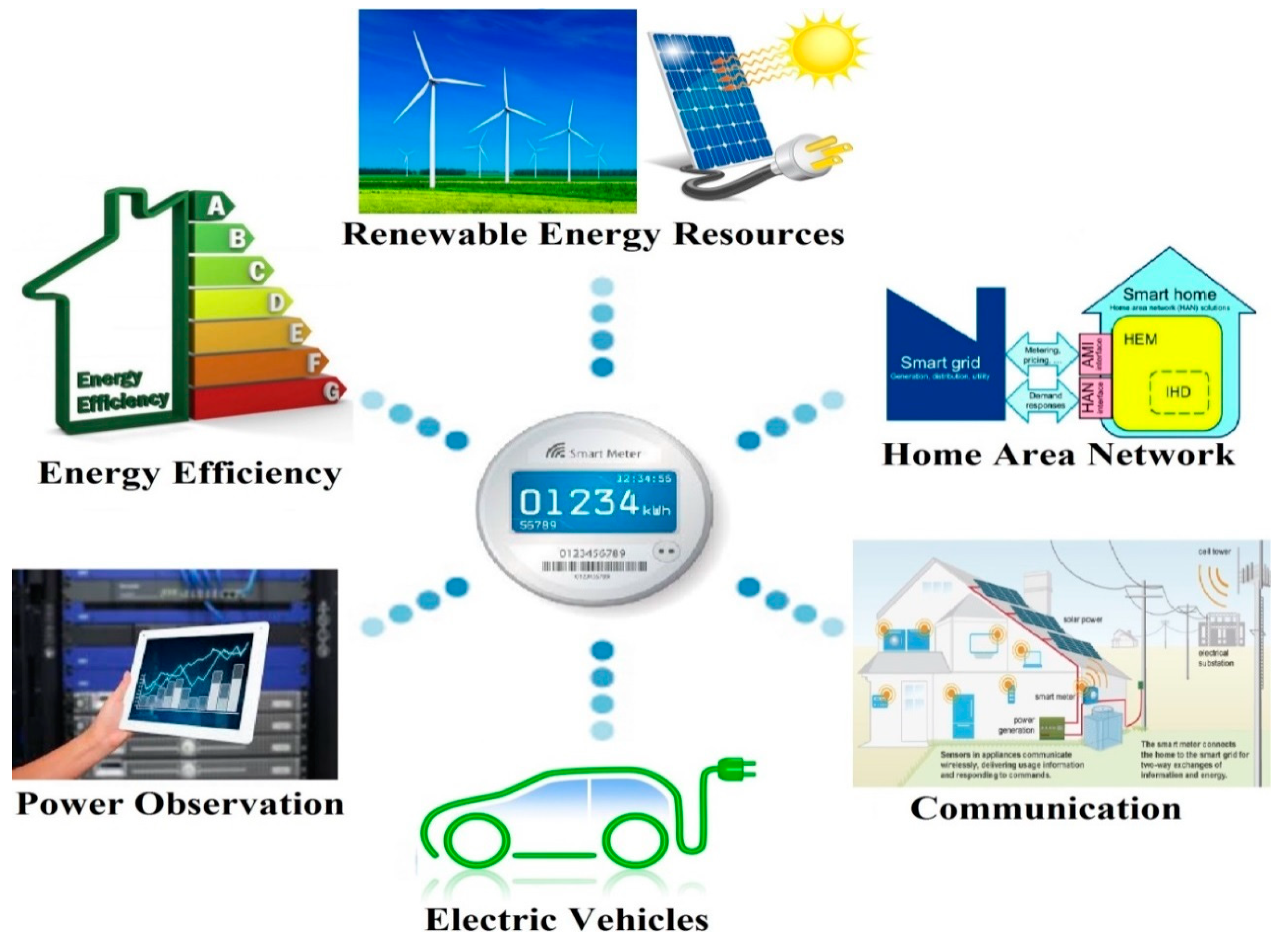
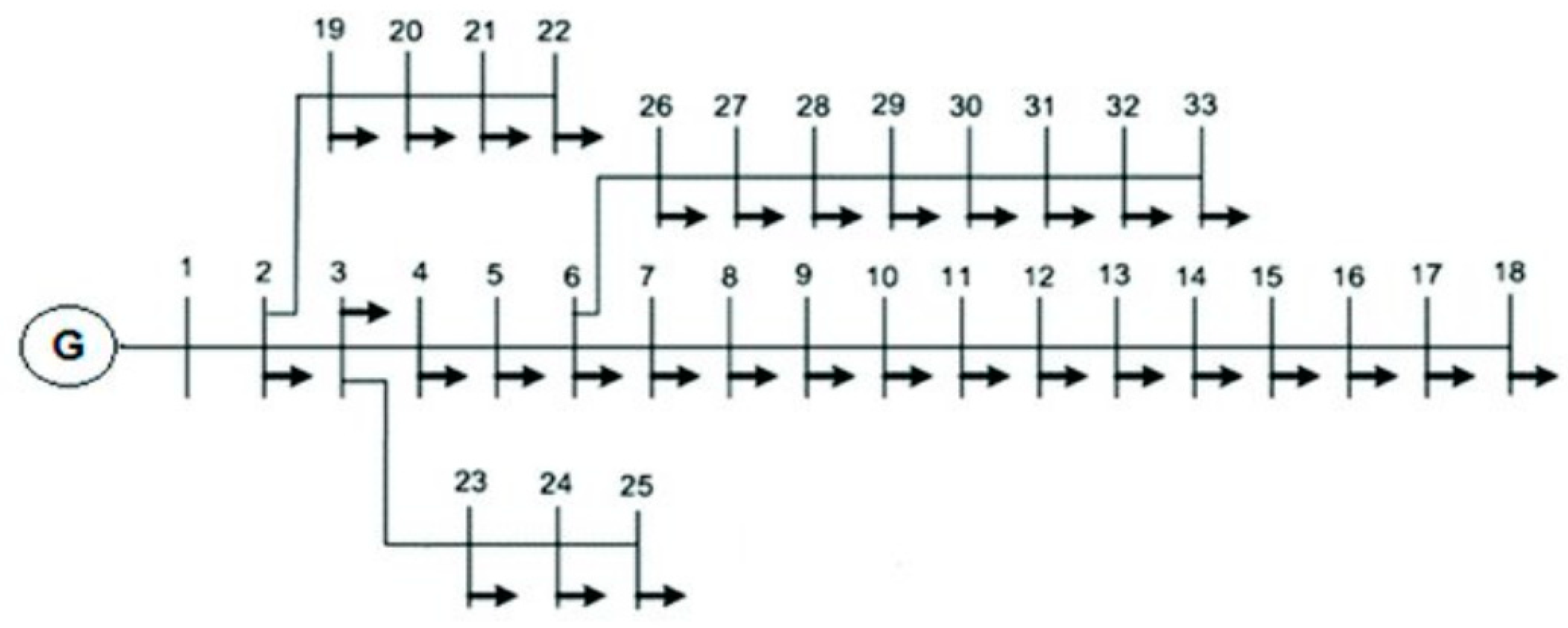
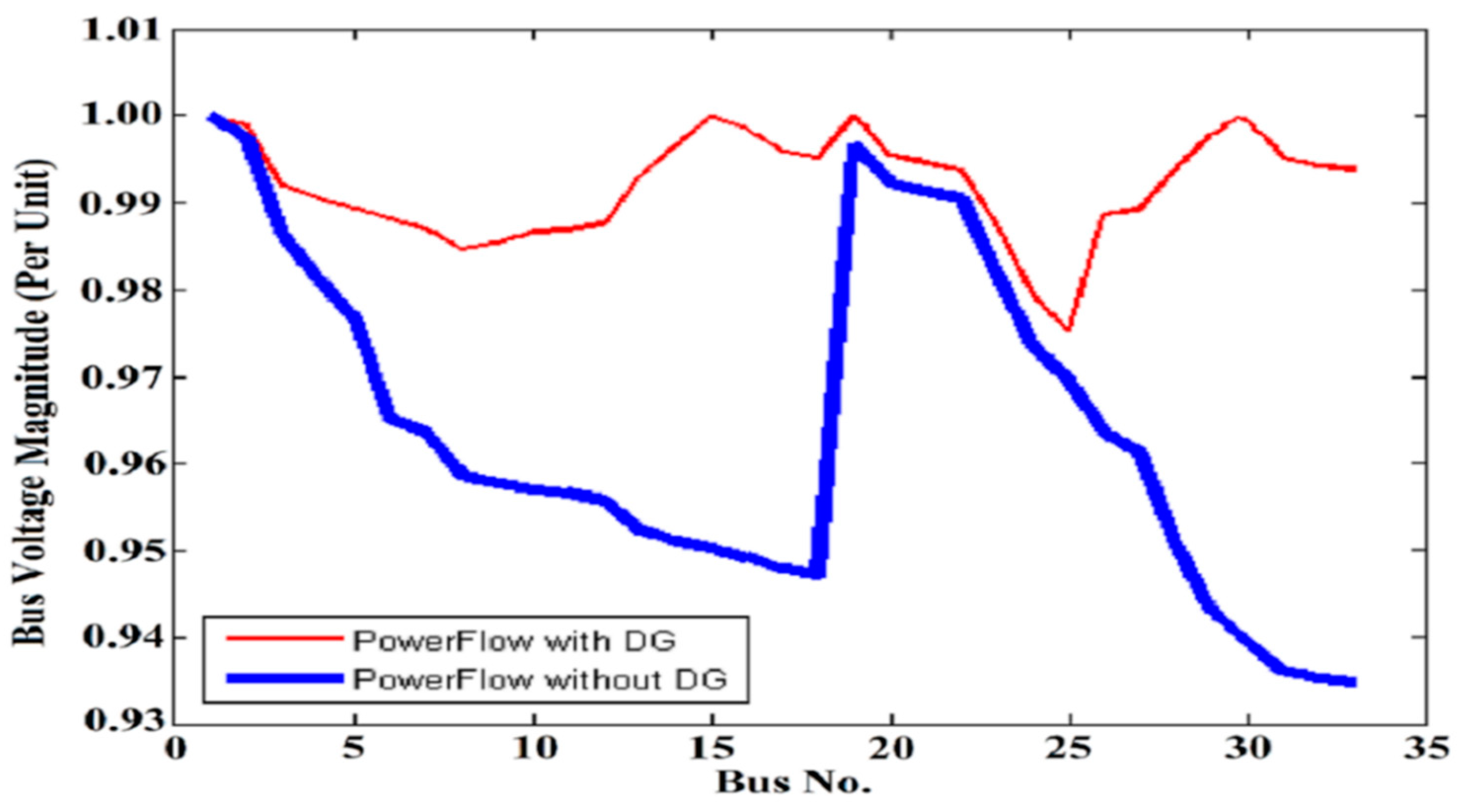
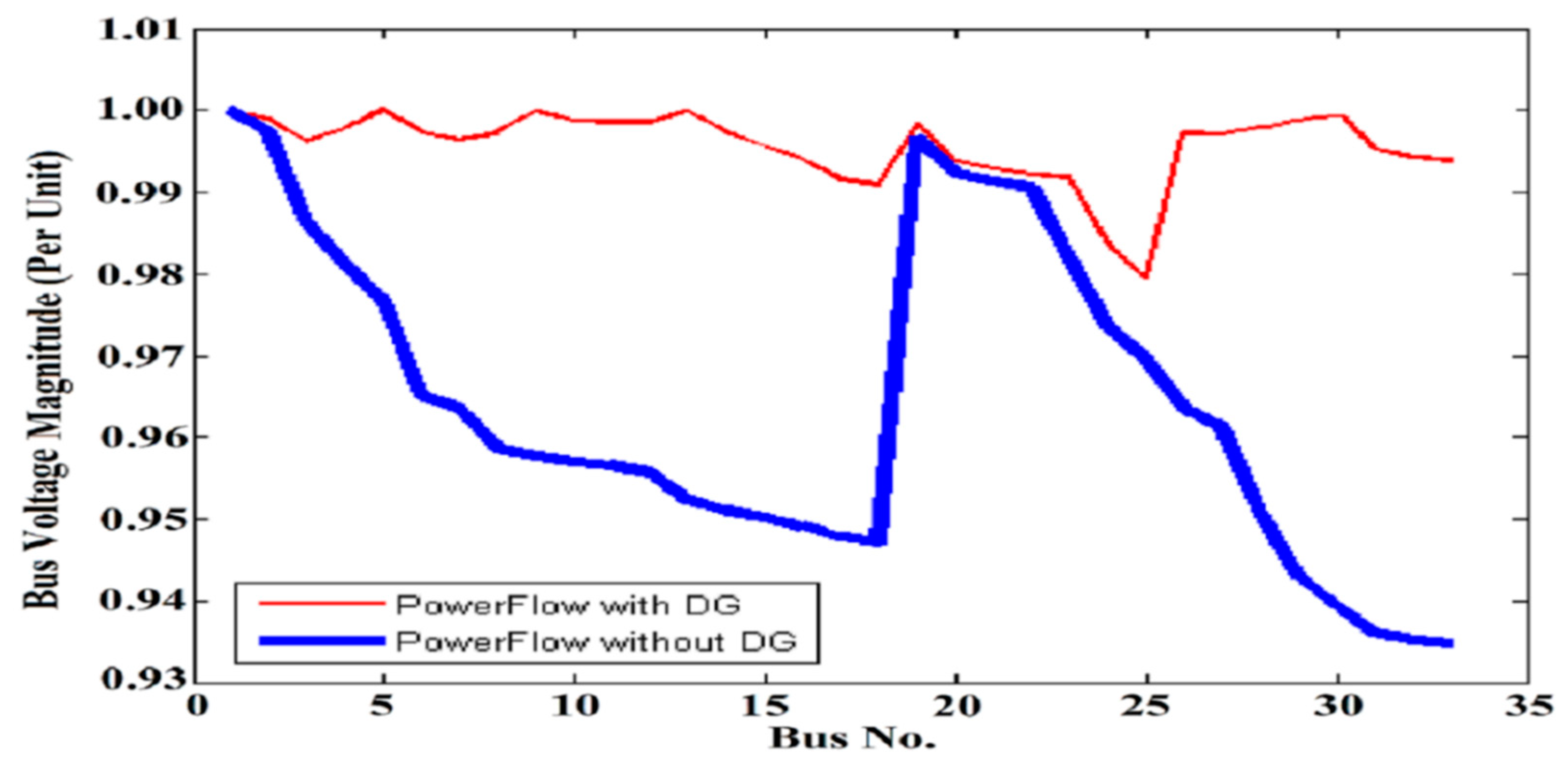

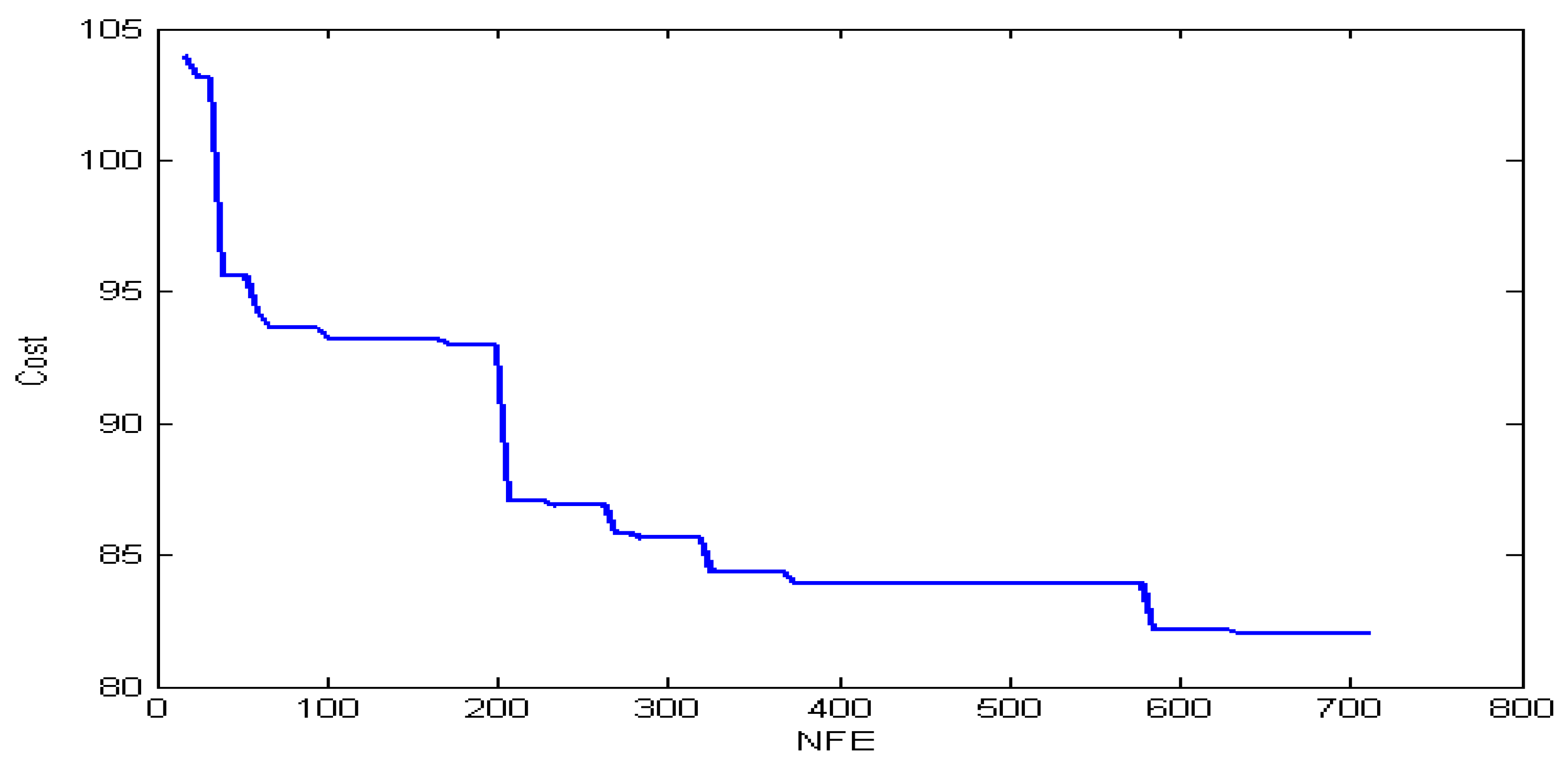
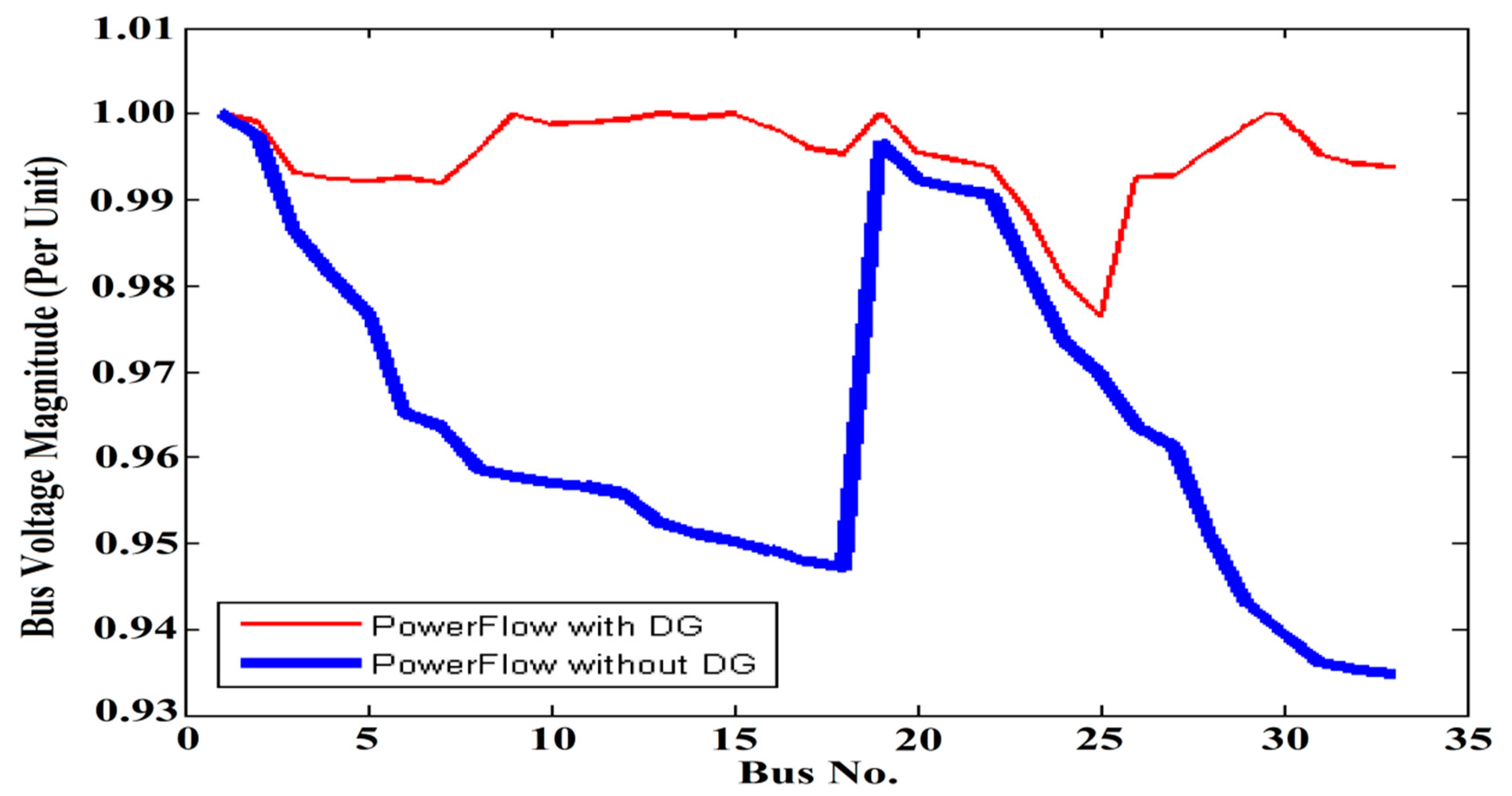

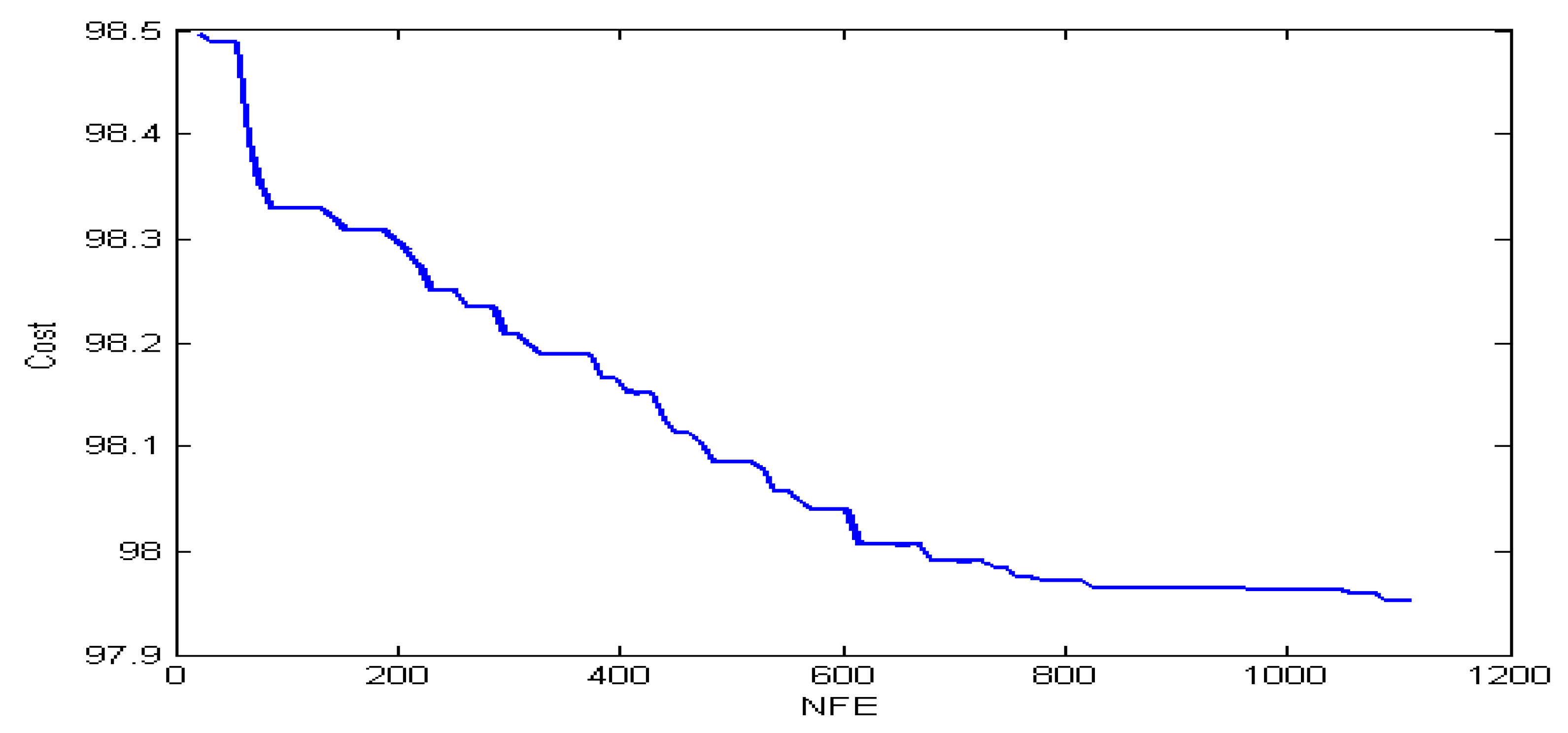
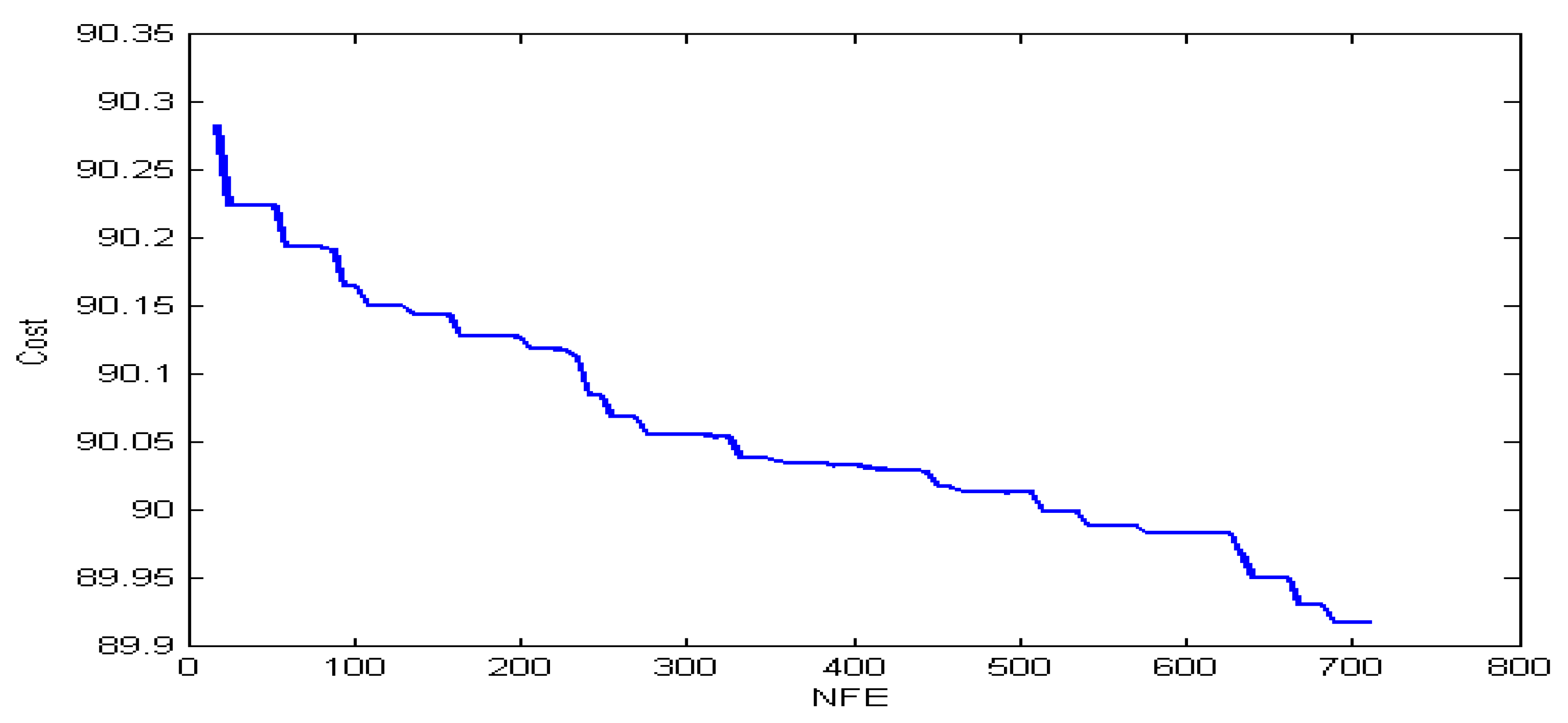
| Power Plant Type | Hydroelectric | Sea | Biomass | Geothermal | Wind | Solar | |
|---|---|---|---|---|---|---|---|
| Characteristics | |||||||
| Amount, Distribution, Variation, Intensity | High worldwide, seasonal, medium to low | Very high in coastal, seasonal, tidal, low | Very high worldwide, weather dependent, medium to low | Medium, cross-plate, up to 600 degrees, low average | High In coastal and mountainous shores, very variable, low average | Extremely high worldwide, daily, seasonal, low pick | |
| Technology; Options | Dams and turbines with different altitude | Low temperature thermodynamic cycles, mechanical wave oscillators, tidal dams | Burning, fermenting, digestion, gas production, liquidation | Steam and double thermodynamic cycles, total current turbines, ground pressure, lava | Horizontal and vertical wind turbines, wind pumps, sail power | Thermal systems with low to high temperature, PVs, inactive systems, biological transformation | |
| Current Status | Often commercial | In development | Some commercial, some in development | Many commercial, some in development | Many commercial, some in development | In development, some commercial | |
| Coefficient, Capacity | Discontinued to base load | Discontinued to base load | Based on the need for short-term storage | High, basic load | Variable, 30–15% | No storage less than 25%, medium | |
| Ways of Progression | Turbine, cost, design, information | Technologically, materials, cost per source | Technologically, agricultural management and forestry | Exploration, extraction, use of hot stones | Material, layout, installation location, information about the source | Material, cost, efficiency, information about the source | |
| Specifications: Environmental Characteristics | Very clean, effect on local aquatic environment, use of the earth | Very clean, effect on local aquatic environment, effect on landscape | Clean, effects on animals and other poisonous waste plants | Clean, soluble gases, water and salt consumption | Very clean, affecting the visibility, noise, the mortality of the birds | Very clean, affecting the landscape and local air, producing Photovoltaic (PV) modules | |
| Number of Transmitted Buses | Number of Received Buses | Number of Transmission Lines | Ohmic Resistance | Inductive Resistance |
|---|---|---|---|---|
| 1 | 2 | 1 | 0.0992 | 0.0447 |
| 2 | 3 | 1 | 0.493 | 0.2511 |
| 3 | 4 | 1 | 0.366 | 0.1864 |
| 4 | 5 | 1 | 0.3811 | 0.1941 |
| 5 | 6 | 1 | 0.819 | 0.707 |
| 6 | 7 | 1 | 0.1872 | 0.6188 |
| 7 | 8 | 1 | 1.7114 | 1.2351 |
| 8 | 9 | 1 | 1.03 | 0.74 |
| 9 | 10 | 1 | 1.04 | 0.74 |
| 10 | 11 | 1 | 0.1966 | 0.065 |
| 11 | 12 | 1 | 0.3744 | 0.1238 |
| 12 | 13 | 1 | 1.468 | 1.155 |
| 13 | 14 | 1 | 0.5416 | 0.7129 |
| 14 | 15 | 1 | 0.591 | 0.526 |
| 15 | 16 | 1 | 0.7463 | 0.545 |
| 16 | 17 | 1 | 1.289 | 1.721 |
| 17 | 18 | 1 | 0.732 | 0.574 |
| 18 | 19 | 1 | 0.164 | 0.1565 |
| 19 | 20 | 1 | 1.5042 | 1.3554 |
| 20 | 21 | 1 | 0.4095 | 0.4784 |
| 21 | 22 | 1 | 0.7089 | 0.9373 |
| 22 | 23 | 1 | 0.4512 | 0.3083 |
| 23 | 24 | 1 | 0.898 | 0.7091 |
| 24 | 25 | 1 | 0.896 | 0.7011 |
| 25 | 26 | 1 | 0.203 | 0.1034 |
| 26 | 27 | 1 | 0.2842 | 0.1447 |
| 27 | 28 | 1 | 1.059 | 0.9337 |
| 28 | 29 | 1 | 0.8042 | 0.7006 |
| 29 | 30 | 1 | 0.5075 | 0.2585 |
| 30 | 31 | 1 | 0.9744 | 0.963 |
| 31 | 32 | 1 | 0.3105 | 0.3619 |
| 32 | 33 | 1 | 0.341 | 0.5302 |
| Number of Buses | 1 | 2 | 3 | 4 | 5 | 6 | 7 | 8 | 9 | 10 | 11 |
| P | 3.8 | 0.1 | 0.09 | 0.12 | 0.06 | 0.06 | 0.2 | 0.2 | 0.06 | 0.06 | 0.045 |
| Q | 2.4 | 0.06 | 0.04 | 0.08 | 0.03 | 0.02 | 0.1 | 0.02 | 0.02 | 0.03 | 0.03 |
| Number of Buses | 12 | 13 | 14 | 15 | 16 | 17 | 18 | 19 | 20 | 21 | 22 |
| P | 0.06 | 0.06 | 0.12 | 0.06 | 0.06 | 0.06 | 0.09 | 0.09 | 0.09 | 0.09 | 0.09 |
| Q | 0.035 | 0.035 | 0.08 | 0.01 | 0.02 | 0.02 | 0.04 | 0.04 | 0.04 | 0.04 | 0.04 |
| Number of Buses | 23 | 24 | 25 | 26 | 27 | 28 | 29 | 30 | 31 | 32 | 33 |
| P | 0.09 | 0.42 | 0.42 | 0.06 | 0.06 | 0.06 | 0.12 | 0.2 | 0.15 | 0.21 | 0.06 |
| Q | 0.05 | 0.2 | 0.2 | 0.025 | 0.025 | 0.02 | 0.07 | 0.6 | 0.07 | 0.1 | 0.04 |
| Bus Number of DG | Type of DG | Installed Capacity (MVA) |
|---|---|---|
| 5 | PV | 1.12 |
| 13 | Wind | 1.54 |
| 15 | Win | 7.62 |
| Bus Number of DG | Type of DG | Installed Capacity (MVA) |
|---|---|---|
| 5 | PV | 6.173 |
| 13 | PV | 6.204 |
| 19 | PV | 6.192 |
| 30 | Wind | 6.204 |
© 2019 by the authors. Licensee MDPI, Basel, Switzerland. This article is an open access article distributed under the terms and conditions of the Creative Commons Attribution (CC BY) license (http://creativecommons.org/licenses/by/4.0/).
Share and Cite
Fathi, M.; Ghiasi, M. Optimal DG Placement to Find Optimal Voltage Profile Considering Minimum DG Investment Cost in Smart Neighborhood. Smart Cities 2019, 2, 328-344. https://doi.org/10.3390/smartcities2020020
Fathi M, Ghiasi M. Optimal DG Placement to Find Optimal Voltage Profile Considering Minimum DG Investment Cost in Smart Neighborhood. Smart Cities. 2019; 2(2):328-344. https://doi.org/10.3390/smartcities2020020
Chicago/Turabian StyleFathi, Mohammadreza, and Mohammad Ghiasi. 2019. "Optimal DG Placement to Find Optimal Voltage Profile Considering Minimum DG Investment Cost in Smart Neighborhood" Smart Cities 2, no. 2: 328-344. https://doi.org/10.3390/smartcities2020020
APA StyleFathi, M., & Ghiasi, M. (2019). Optimal DG Placement to Find Optimal Voltage Profile Considering Minimum DG Investment Cost in Smart Neighborhood. Smart Cities, 2(2), 328-344. https://doi.org/10.3390/smartcities2020020






